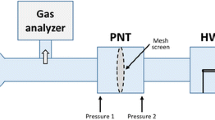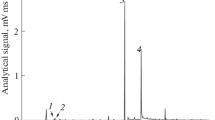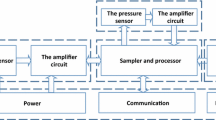Abstract
Spurious readings from a mass spectrometer have been reported following the administration of aerosol bronchodilators. We quantified the response of various respiratory gas analyzers to the aerosol propellant of albuterol inhalant (Proventil). The mass spectrometer systems tested, two Advantage systems, a SARA system, and a Model 6000 Ohmeda system, all displayed artifactual readings in response to the albuterol propellant. Each metered dose of the Proventil brand of albuterol contains 4 ml of Freon 11 (trichloromonofluoromethane) and 11 ml of Freon 12 (dichlorodifluoromethane). The concentration of propellant was expressed in doses/L, where each liter of gas contains 0.4 vol % of Freon 11 and 1.1 vol % of Freon 12 per dose. In proportion to the concentration of albuterol propellant, the two Advantage systems showed substantial readings of isoflurane (%) when no isoflurane was present (13% and 16% per dose/L) and reduced readings of enflurane (−8% and −10% per dose/L) and carbon dioxide (CO2) (−3 and +5 mm Hg per dose/L). The SARA system showed substantial CO2 readings when no CO2 was present (5 mm Hg per dose/L) and displayed small enflurane readings (0.1% per dose/L) when no enflurane was present. The Model 6000 unit showed CO2 readings when no CO2 was present (5 mm Hg per dose/L). Neither the Raman spectrometer, the infrared spectrometers, nor the piezoadsorptive analyzer we tested showed an artifactual effect of albuterol propellant on any of its readings. Simulation and clinical tests demonstrated that a single dose of albuterol propellant into a breathing circuit at the onset of inspiration resulted in concentrations of 0.8 and 0.3 dose/L, respectively. The phenomenon may be clinically useful, by allowing the anesthetist to verify the uptake of an inhalant into a patient.
Similar content being viewed by others
References
Gravenstein N, Theisen GJ, Knudsen AK. Misleading mass spectrometer reading caused by an aerosol propellant. Anesthesiology 1985;62:70–72
McCleary U. Potential effects of an unknown gas on mass spectrometer readings. Anesthesiology 1985;63:724–725
Knudsen AK, Johnson JV, Yost RA. More on mass spectrometers and aerosol propellants. Anesthesiology 1985;63:568–569
Severinghaus JW, Young WG. A gas mixer for computer calibration of anesthetic mass spectrometers. J Clin Monit 1986;2:223–229
Author information
Authors and Affiliations
Rights and permissions
About this article
Cite this article
Elliott, W.R., Raemer, D.B., Goldman, D.B. et al. The effects of bronchodilator-inhaler aerosol propellants on respiratory gas monitors. J Clin Monitor Comput 7, 175–180 (1991). https://doi.org/10.1007/BF01618119
Received:
Revised:
Accepted:
Issue Date:
DOI: https://doi.org/10.1007/BF01618119




